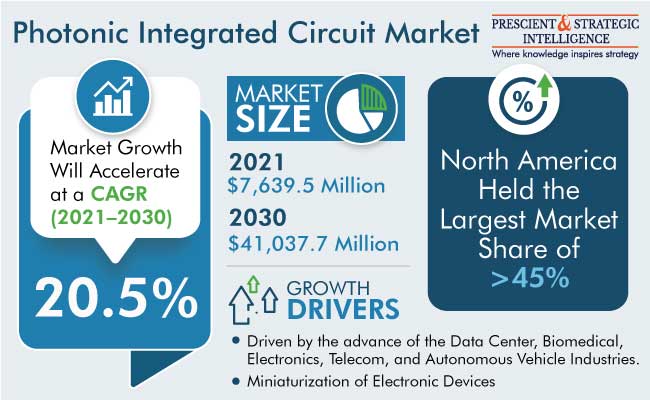Why Is North America Leader in Photonic Integrated Circuit Market?
A photonic integrated circuit (PIC) is a microchip with photonic components, which are parts that work with light, as opposed to electrical elements that create a functional circuit and are found inside your computer, smartphone, and other electronic devices.
The global photonic integrated circuit market is set to increase to $41,037.7 million by 2030. The market is being driven by the significant need for such parts from the telecommunications, medicinal, and data center facilities, the growing popularity of autonomous cars, rapid automation in various industries, and the downsizing of electronic equipment.
III-V Material Attained a Significant Industry Share
Based on raw materials, the III-V material category has a market share of almost 81.8%. The development of 3D depth sensing technology in consumer electronics, LiDAR, automotive lighting, IR LED, and horticulture lighting applications is to blame.
The silica-on-silicon category also has the second-largest industry for photonic integrated circuits. This is owing to the photonic integrated circuits built of this material are economical to fit and operate.
Additionally, since these components are simple to incorporate into electrical devices, there is a huge market opportunity for companies that provide the silica-on-silicon platform.
Additionally, the need for high-speed, low-cost, broad bandwidth and high energy efficiency data flows are driven by the fast-growing traffic on telecommunications networks, the increasing need for data centers, and the expanding usage of high-performance computers.
What Sectors and Uses Might PICs be Beneficial for?
Data transmission is one of the main application areas for PICs, followed by sensing, biological applications like lab-on-a-chip devices, uses in the aerospace and defense sectors, and applications in the field of astronomy.
As engineers tackle new technical problems, integrated photonics can be helpful, and feasibility studies can decide whether it offers the potential of a solution.
As a result, PICs continue to advance and discover new uses. PIC consortia, design studios, and even certain universities throughout the world provide their services for such investigations.
PICs have the potential to replace electronic integrated circuits as the dominant platform for data communications, LiDAR technologies for autonomous driving, sensing for aeronautics and aerospace, and much other future uses in a new technological era.
Why Is North America Leading Global Sector?
Due to the broad use of WAN technologies for fiber-optic communications and data centers, North America has the biggest share in the photonic integrated circuit market, at around 45.0%.
Additionally, the increased adoption of IoT and the growing need for high-speed data transfer add to the strain on cloud computing networks, which has led to the possible development of a burgeoning photonic integrated circuit industry in the area.
Moreover, businesses have begun to turn toward integrated circuits as a result of the rise in data creation, consumption, and bandwidth needs. These components rely on light and photons rather than electricity and electrons to provide wider bandwidth and more efficiency.
They may therefore be a crucial facilitator of several future applications. Numerous cutting-edge technologies, including quantum computing, are supported by PICs.
Read More: https://www.psmarketresearch.c....om/market-analysis/p
